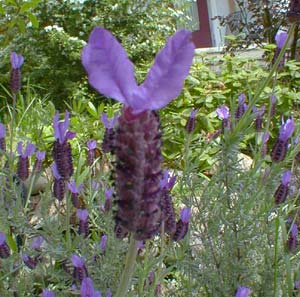 Spanish Lavender; aka,
Spanish Lavender; aka,
French Lavender; aka,
Rabbit Ears; aka,
Papillon or Butterfly Lavender
"The night is fresh-washed & fair & there
is a whiff of flowers in the air.
Wrap me close, sheets of lavender.
Pour your blue & purple dreams into my ears."
-Amy Lowell,
1874-1925
is a whiff of flowers in the air.
Wrap me close, sheets of lavender.
Pour your blue & purple dreams into my ears."
-Amy Lowell,
1874-1925
Spanish Lavender (Lavandula stoechas ssp pedunculata) spends its first year in the ground settling in. Its second year it really takes off, spreading rapidly, & sewing its seeds some distance. It dislikes being disrupted thereafter, & should never be transplanted.
If there are dry unplanted areas you're neglecting to plant, but wouldn't mind if something would grow there pretty much on its own with no attention, Spanish Lavender is the stuff. It was given the Award of Garden Merit in 1993, reconfirmed after new trials in 1999.
It will grow very easily in USDA zones eight through ten, needing a touch of shade in zone ten. It loves a sunny location, where it grows to two feet in height, three counting the flower stems. It blooms marvelously & fragrantly all spring & summer, sometimes even into autumn. When the blooms are spent, it's a good time to trim the plant a bit shorter, as it will otherwise get stringy & spread outward & potentially get out of hand if never sheared.
Cultivated in North America since 1735, the species is native of the whole of the Mediterrean from Portugal & Spain to North Africa & Syria. It is often designated French Lavender which is just as correct, although L. dentata is also called French Lavender, so Spanish is preferred for L. stoechas ssp pedunculata. It is also sometimes but mistakenly called Italian lavender, though strictly speaking, only the shorter-flowered L. stoechas ssp stoechas is from Italy (we have the Italian white variant, L. stoechas ssp stoachas var leucantha). Additionally there are subspecies too tender to be commonly gardened, including L. stoechas cariensis the Turkish Lavender, & L. stoachas Sampaioana, Portugese Lavender.
A whimsical secondary common name for this evergreen is Rabbit Ears because of the form of the blooms, which consist of barrel-shaped peduncles with two or more "rabbit ears" on top. The name Papillon (Butterfly) alludes to the same charming feature. The May photo above more than adequately illustrates the reason for such names! The ears are large sterile bracts rather than flower petals.
The folknames Steckado, Stichados, & Stickadove, are possibly only corruptions of the species name stoechas which alludes to islands off the coast of Marsellaise, known to the ancient Greeks by this name. But "Stickadove" is particularly odd, as the flowers could be perceived as doves atop sticks, if only doves were purple. The Italian subspecies does have a white form, & that one might indeed conjure a fantasy of tiny doves sitting on sticks.
The flowers dry easily for food use, but for dried-flower bouquets, the ears are too brittle to last, though it's worth a try. Hang bouquets upside-down in a dark corner near the ceiling of a warm room. When completely dry they will still have their color & aroma. If they're too fragile whole for arrangements, then just take the flowers & bottle them to stay fresh for cooking. But to attempt in dry flower arranging would require them to be sprayed with a clear lacquer.
These blossoms taste more like eucalyptus & rosemary than do other culinary lavenders, so aren't as good for deserts as would be the true English Lavender. But the flowers lend a pleasing flavor to vinegar, can be mixed not too liberally with berries sweetened & cooked for jams, or crystalized in sugar to use as cake decorations. The antiquated folknames Candy Cassidony (a quartz agate) & Candy Rosemary came about due to their very use as edible cake decorations glazed white with sugar. Meat eaters (that would not include me) may wish to mix the dried flowers with garlic & fresh ground black pepper for roasts.